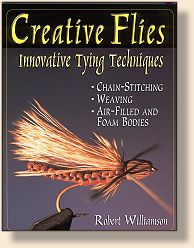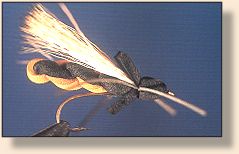Twisted Stonefly Adult
By Robert Williamson
Foam Twister Technique
With the advent of thin, closed-cell foam in colors suitable
for fly tying, tiers are creating durable foam flies with
great flotation. The foam twister is a way to use this thin,
closed-cell foam to create extended-body dry flies. This technique
works well for stonefly adults, hoppers, cicada, yellow sallies,
damsel adults and the giant orange sedges. Creative tiers will
come up with other patterns as this technique catches on.
The foam twister technique is nothing more than twisting
strips of thin foam until it doubles back on itself. The
twisted foam is then tied on the hook shank to create an
extended body. The rest of the fly pattern is tied around
the attached body. Two-tone or multicolored bodies can be
made by layering or stacking different colors of foam
together before twisting.
There are several companies selling thin, closed-cell foam, be
sure to use the sheet foam. Rainey's Sheet Foam is available
in several colors and works well with the twister technique.
Hand and Finger Movements for the Foam Twister Technique
 Step 1: Cut a 3" x 1/8" strip from a piece of sheet foam
If you are tying two-toned bodies, or multicolored bodies, marry
the separate colors together by layering them before twisting.
Two-toned or multicolored bodies require the foam to be cut a
little thinner than with the standard one-color bodies.
Step 1: Cut a 3" x 1/8" strip from a piece of sheet foam
If you are tying two-toned bodies, or multicolored bodies, marry
the separate colors together by layering them before twisting.
Two-toned or multicolored bodies require the foam to be cut a
little thinner than with the standard one-color bodies.
 Step 2: Take the foam strip in each hand by the thumb and index
finger. Twist the foam by rolling the thumb and index finger on
the right hand away from you while rolling the thumb and index
finger of the left hand toward you. As the foam starts to twist,
move the thumbs and index fingers toward each other, relaxing the
tension on the foam. The foam should start to double up on itself
near the middle of the foam strip.
Step 2: Take the foam strip in each hand by the thumb and index
finger. Twist the foam by rolling the thumb and index finger on
the right hand away from you while rolling the thumb and index
finger of the left hand toward you. As the foam starts to twist,
move the thumbs and index fingers toward each other, relaxing the
tension on the foam. The foam should start to double up on itself
near the middle of the foam strip.
 Step 3: When the foam is doubled up, grap the tag ends in one hand
to keep it from unraveling. On the top of the hook shank, bind
down a section of twisted foam equal to the length of the shank.
The twisted body should be bound down a little forward of the
middle of the shank. The body should extend back over the bend of the
hook. Leave enough room to tie in wings, legs and a head.
Step 3: When the foam is doubled up, grap the tag ends in one hand
to keep it from unraveling. On the top of the hook shank, bind
down a section of twisted foam equal to the length of the shank.
The twisted body should be bound down a little forward of the
middle of the shank. The body should extend back over the bend of the
hook. Leave enough room to tie in wings, legs and a head.
The Twisted Stonefly is a fun pattern with which to experiment. I like
to add a layer of black foam to the orange or rust foam, giving it a
neat two-tone appearance. Black and red would make a nice color
scheme. The body color can be changed to dark brown and yellow,
making a good golden stonefly imitation. The color of the head and
legs can be changed too.
Materials: Twisted Stonefly Adult
Hook: Tiemco 5212. Size: 6, 8.
Thread: Brown or Orange.
Body: Orange and black, closed-cell sheet foam.
Wing: Blonde bull elk hair.
Head: Black or dark brown closed-cell sheet foam.
Legs: Black rubber leg material.
Tying Steps:

1. Take a 3" x 1/8" strip of black closed-cell foam and marry it
with a strip of orange foam of the same size. Make a twisted body
by using the twister technique at the top of the article. Tie in
the preformed twisted body slightly forward of the middle of the
shank.

2. Even the tips of some elk hair. Tie this in to form the
wing. The hair tips should be even with the extended body.

3. Cut out a section of black sheet foam 3/4" long by 1/4" wide.
Pike a hole through the center of the foam with your bodkin. Push
this foam section over the eye of the hook and bind it down, forming
a foam head. Trim the top and bottom portion of the protruding foam
ends. The foam head can be shorter and thinner depending on the
size of the stonefly being tied.

4. Tie in rubber legs on each side of the stonefly.

6. Bottom view.
~ Robert Williamson
 Fishing Instructions:
For more information on Stoneflies, and how to fish them,
click HERE.
~ DLB
Credits: From Creative Flies by Robert Williamson,
published by Frank Amato Publications. We greatly appreciate use permission.
|



